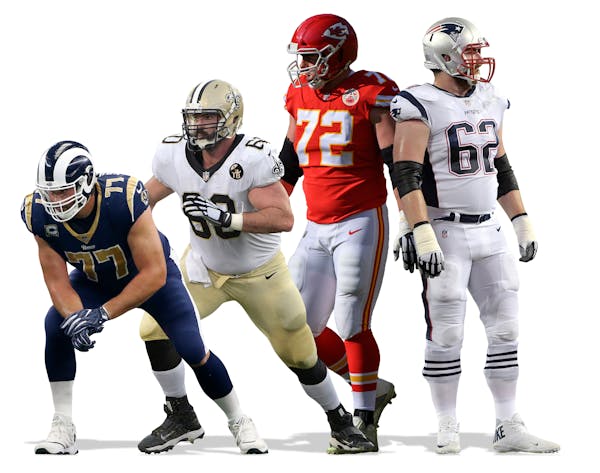It was March 14, 2018, and the Patriots were doomed.
Again.
Well, maybe not doomed. But surely they were making a grave error in letting left tackle Nate Solder walk out the door via free agency.
Right?
Solder was 29. The 17th overall draft pick in 2011. Protector of the GOAT Tom Brady's blind side through six seasons and four Super Bowls.
No matter. Too expensive. Nice knowing ya, Nate. Next affordable Patriots puzzle piece up! Pat Shurmur's Giants swooped in, guaranteed Solder $34.8 million on a four-year, $62 million deal and smiled all the way from the bank.
Fast forward 10 months.
The Giants went 5-11 while paying Solder $21.9 million in 2018 with another $12.9 million guaranteed coming in 2019.
The Patriots?
All they did was go 11-5 and maul the Chargers in last week's conference semifinals en route to their eighth straight AFC Championship game Sunday at Kansas City.
Total out-of-pocket expenditure for New England's ENTIRE starting offensive line: $8,344,000.
Left tackle Trent Brown's share of that loot: $1,907,000 — or $20,007,000 less than Solder was paid in 2018 in salary and signing bonus.
The Patriots have led the way again. In this case, they have shown the league how to build a wall when the choices aren't so obvious.
They went into the 2018 draft after losing Solder to the Giants and Cameron Fleming to the Cowboys. First, they did the obvious, using the 23rd overall pick to select Georgia tackle Isaiah Wynn, who tore an Achilles' tendon and missed the entire season.
Then they pulled an under-the-radar move that barely was mentioned. On Day 2 of the draft, they dealt a third-round pick to the 49ers for the 6-8, 380-pound Brown and a fifth-round pick.
Brown was a seventh-round pick of the 49ers in 2015. He had started 28 games, but mostly as a right tackle.
The Patriots' eye for talent saw starting left tackle potential in the feet of a body that's bigger than even most right tackles. Naturally, they weren't wrong.
Brown wasn't perfect. He gave up 35 pressures, including three sacks, in 579 pass plays to rank 39th among tackles in pass blocking efficiency, according to Pro Football Focus (PFF).
But as a unit, the Patriots offensive line ranked seventh, giving up 134 pressures in 598 pass plays. In other words, Brown wasn't dominant, but he followed Bill Belichick's mantra and did his job as the Patriots won their 10th straight AFC East title with an offensive line made up of a guy who went undrafted (David Andrews), a third-rounder (Joe Thuney), a fourth-rounder (Shaq Mason), a fifth-rounder (Marcus Cannon) and a seventh-rounder (Brown).
Then came last week. The Chargers had the better record, momentum and a defense coming off a seven-sack performance at Baltimore.
When PFF was done crunching the numbers on the performances of the eight semifinalists, the Patriots had posted the top center (Andrews), the top two guards (Mason and Thuney) and the top tackle (Brown).
In 44 dropbacks, Brady was hurried five times with no sacks or hits. Brown allowed one hurry.
Of course, it helps to have the savviness of a five-time Super Bowl-winning QB. Of the eight QBs who played last week, Brady had the fastest release time, 2.13 seconds, according to PFF.
This year's four finalists are a combined 53-15 and represent the top two seeds in each conference for the first time since 2015. Each team is different, yet all have much in common, including perhaps the most essential strength in football:
Offensive line.
According to PFF, each team ranks in the top 11 in pass-blocking efficiency. The Chiefs are sixth followed by the Patriots (seventh), Saints (ninth) and Rams (11th).
Each team also can run the ball when it wants or needs to. And that makes each team's play-action attack all the more formidable.
The four finalists also have shown that not all lines have to be built by following Mel Kiper Jr.'s latest first-round mock draft.
Only four of the 20 starting linemen still playing were first-round picks. Only three of them are with the team that drafted them.
Ten of the 20 were drafted by their current team. Four were acquired during free agency. One was claimed off waivers. One was signed off the street as a rookie after being cut from his third practice squad. One was signed as an undrafted rookie. And three came via trades, including Brown, who switched sides of the country when Solder followed the big bucks to the Big Apple.
So there are many ways to build a wall in the NFL. The key is being able to spot a good brick when it's obvious and even when it's not so obvious.
Mark Craig is an NFL and Vikings Insider. Twitter: @markcraigNFL. E-mail: mcraig@startribune.com
Kansas adds AJ Storr after he led Wisconsin in scoring this season
Butler, Williamson injuries are part of story for Heat-Bulls and Kings-Pelicans play-in finales

